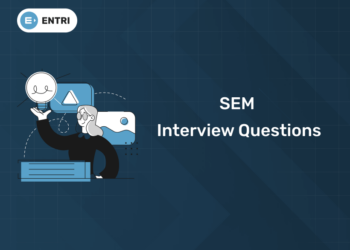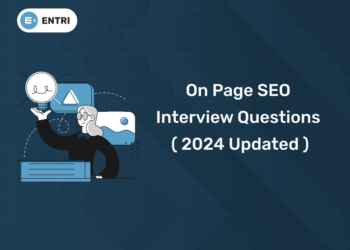Table of Contents
A landing page is a website created with the intention of converting visitors into leads, clients, or customers. Convincing visitors to perform a certain action, like completing a form, buying something, or subscribing to a newsletter, is the primary goal of a SEO landing page.
Digital marketing strategies including pay-per-click (PPC), email, and social media advertising frequently employ landing sites. To improve the likelihood of visitors becoming leads or customers, these efforts direct traffic to a designated landing page rather than the website’s home page.
Learn Digital Marketing Fundamentals! Get Free Demo Here!
Introduction
A website can increase its exposure in search engines like Google by implementing SEO techniques, which ultimately lead to an increase in organic traffic. The goal of SEO is to satisfy consumers search requirements by producing excellent, relevant content and provide the greatest user experience. The main objective of search engine optimisation (SEO) is to improve a website’s organic traffic by increasing its relevance and authority to search engines such as Google, Bing, and Yahoo.
Both on-site and off-site SEO tactics are possible. Because of this, SEO is frequently separated into “on-page” and “off-page” categories.
- Research on keywords
- Generation and optimisation of content
- Technical enhancement
- Link establishment
What is SEO?
On-Page SEO: On page SEO is to increase relevance and visibility of a page for particular keywords or themes, it is necessary to enhance each individual pages. Optimising the headings, content, graphics, URLs, and meta tags (title tags and meta descriptions) is a part of the on-page SEO.
Off-Page SEO: The term “off-page SEO” is describes the efforts made outside of a website to increase its authorization and visibility. This will ensures social media marketing, online reputation management, and constructing backlinks from any other truthful websites.
Technical SEO: The main goal of technical SEO is to enhance a websites overall performance and indexability by optimising its technical elements. This involves making sure the website is user-friendly, integrating schema markup, resolving broken links, and optimising perfomance of the website.
Local SEO: The goal of loacal SEO is Optimising a website or business for local search results. In order to achieve the, local quotation, Google My Business listings, and NAP (Name, Address, Phone number) consistency across internet directories must all be optimised.
Understanding SEO Landing Pages:
A landing page is usually the first page of a website that a user sees after clicking on a search engine result in the context of SEO. Landing pages can significantly affect a website’s conversion rate and search engine rankings, thus it’s critical that they are optimised for both users and search engines.
This indicates that search engines can easily comprehend and rank the page because of the way it is structured and constructed. The creation of a landing page optimised for search engines requires a few essential components.
Key elements of SEO landing page:
- Headline: Since the headline is the first thing visitors will see on a landing page, it is the most crucial component. It should appropriately represent the information of the landing page and be succinct, compelling, and clear.
- Content: The landing page’s content should be simple to read and comprehend, pertinent to the offer or good or service being advertised. It is important to strategically insert keywords into the material.
- Form: Should the landing page have one, it ought to be brief and simple to fill out. In order to save visitors from having to scroll down to find it, it should also be positioned above the fold.
- Videos and images: These elements can contribute to the persuasiveness and engagement of a landing page. They ought to be optimised for online performance and pertinent to the deal or item being advertised.
- Call-to-action (CTA): An action-oriented, conspicuous, and unambiguous CTA is ideal. It should make it obvious to the user what to do next (for example, “Sign Up Now,” “Learn More,” or “Buy Now”).
- Navigating: There shouldn’t be much navigating. It shouldn’t draw attention away from the landing page’s primary objective.
- Social proof: In order to establish credibility and trust with potential clients, testimonials and other types of social proof can be helpful.
Importance of SEO Landing Pages:
The SEO landing pages are very essential for raising the conversion rates, directing targeted audience to their websites, and increase the visibility of website. Businesses may be qualified in leads and prospects who are actively looking for their goods or services. And by optimising the landing pages for relevant keywords and offers perceptive content. Also the well designed landing pages can be improve the user experiences and eventually helping the website ranking higher in the search results.
Learn Digital Marketing Fundamentals! Get Free Demo Here!
Why Need of SEO landing pages
Most of Businesses trying to increase their online visibility, given in to targeted audiences, and more successfully accomplish their marketing goals as well. And they were finds the SEO landing pages to be an useful resource. In the internet marketing, businesses can improve their chances of success by enhancing the landing pages for both consumers and search engines. For several reasons SEO landings pages are very essential,
Higher Positioning in Search Engines:
Here, with SEO landing pages, you may increase your chances of ranking higher in search engine results pages (SERPs) by promoting them to particular targeted keywords or search queries. Businesses may optimises their online presence and draw in more target audiences by improving landing pages for relevant keywords.
Targeted Web Traffic
In this section, with a particular purposes in mind, such as generating leads, marketing a product, or increasing conversions rates, SEO landing pages were created. Businesses may enhance the possibility of conversion rates by directing highly relevant and targeted traffic to their landing pages by focusing on a particular keywords and search queries.
Improved User Experience:
In order to give users and search engines alike the best possible experience, SEO landing pages are maintained for both. Through the provision of insightful content, that is calls-to-action (CTAs), and user-friendly navigation. Also the companies may enhance user experience and boost many purposes on these landing pages.
Higher Rates of Conversion:
The purpose of SEO landing pages is to attract the users to complete a desired activity, like submitting a form, making a purchase, or signing up etc. Businesses can be improved in their conversion rates and will more successfully accomplish their marketing goals by altering landing pages to maximise conversions and eliminates interference.
Improved Monitoring and Analytics:
Businesses can more efficiently monitor and evaluate visitor behaviour, engagement, and conversion data with SEO landing pages. Businesses may obtain important insights into how users engage with their landing pages and make data-driven adjustments to enhance performance over time by utilising analytics tools like Google Analytics.
Economical Marketing:
An affordable strategy for drawing in targeted visitors and producing leads or sales is through SEO landing pages. SEO landing pages have the potential to generate organic traffic and conversions over time, offering a long-term return on investment (ROI), in contrast to paid advertising campaigns that demand continuous funding.
How to create an SEO friendly landing Page
Optimising conversions and drawing in organic search engine traffic require the creation of an SEO-friendly landing page. The following is a step-by-step approach to assist you in making an SEO-optimized landing page:
Step 1: Specify the landing page’s objective
It’s critical to comprehend the landing page’s goal before developing it. A landing page may be used for a number of purposes, including lead generation, product or service promotion, or traffic generation to other website pages. Here we note down some common objectives for landing pages:
- Lead Generation: Capturing visitors information, such as name and email, in exchange for a valuable resource is the primary goal of the landing page.
- Product or Service Promotion: The landing page aims to promote a specific product or service. Then highlight its features and benefits, and encourage visitors to make a purchase.
- Event Registration: This landing page is designed tomaintain registrations for an upcoming event, webinar, workshop. Or providing conferences by giving event details and a registration form.
- Content Download: This landing page requests contact information in exchange for downloaded materials, such as e-books, whitepapers, tutorials, or templates.
Step 2: Make a new layout or select a design template
In this section, you can choose from a variety of templates that many website builders and landing page software offer. Customising them to match your brand and the purpose of your page. In the tools section, we’ll also talk about a few landing page creation tools.
- Identify Branding Elements: Make sure that the design layout complements the visual identity of your brand, which includes the logo, colours, fonts, and pictures. Maintaining consistency in branding aids in building visitor recognition and trust.
- Consider User Experience (UX): Select a layout that gives user’s experience first and facilitates navigating the page, locating pertinent information. Make sure the layout is clear, simple, and user-friendly, and include prominent calls-to-action (CTAs).
- Responsive Design: It means selecting design template that is mobile adaptive, which means it can be adjusted to different screen sizes and devices with ease.
Step 3: Write an attention-grabbing title
Here in this step describes that, make a title that catches the readers eye and expresses the benefits of your offer in a concise manner. Like, “Get 50% off your first purchase today!” is one example. To write headlines that will attract readers to click, also you can utilise free title-generation tools like Co Schedule’s Headline Analyzer.
Step 4: Include form and content
It is important to use precise, succinct language together with pertinent keywords while describing your service and its advantages. Make sure to include all relevant details, including the cost, the availability, and client testimonials. For instance, “Access to our private online community and a customised exercise programme are included in our premium service.”
Step 5: Use eye-catching and relevant images
An eye catching images is relevant to attract the users. So text that is visually appealing with images might improve the website’s seo. And it is imperative to use relevant images that support theme of the page.
Step 6: Make use of an attention-grabbing CTA
In this step it is very clear to understand that, the call-to-action (CTA) is the link that users will click to finish the desired action, like making a purchase or subscribing to a newsletter. The call to action needs to be clear and easy to find. Consider the phrases “Shop now” and “Sign up” etc.
Step 7: SEO optimisation
Seo optimisation defines that, you should include keywords in your title tags, meta descriptions, and content to improve the chances that your page will rank well in search results.
- Find relevant terms that individuals interested in your landing page are likely to use by making keyword research. Use keyword research tools to find high-volume, low-competition keywords.
- Make sure your titles and meta descriptions include the keywords you wish to target. Since meta tags are the first thing users will see in the search results, make them engaging and instructional to get them to click through.
- Use headers like (H1, H2, H3) that naturally contain keywords. Ensure that the material you publish is relevant to the keywords you wish to target, well-written, and be helpful.
Step 8: Make mobile friendly
This very important step in landing a page. You should make sure the landing page functions and looks good on the mobile devices, as most of peoples are accessing the internet through smartphones.
- Use responsive design techniques to ensure that your landing page functions properly on different screen sizes and devices. This facilitates the reading and accessibility of your content on smartphones, tablets, and other mobile devices very easily.
- The most important elements and removing unnecessary features, you may make your landing page’s design easier for users on mobile devices.
- Make sure you adjust images for mobile devices without sacrificing its quality. This improves the browsing experience for mobile users by using less data and loading pages more quickly.
Step 9: Evaluate and enhance
This is the last and most important step in which several iterations of your page with various CTAs and designs to see which one performs the best. Utilise the information you receive to enhance the page and boost conversions.
- Monitor Performance Measures: Use web analytics tools like Google Analytics to measure and monitor critical performance data in real-time. To find out more about how users are interacting with your landing page, look at data on user behaviour, traffic sources, and conversion funnels.
- A/B Testing: Look through multiple versions of landing pages and use A/B testing to ascertain which elements perform best. To maximise conversion rates, experiment with aspects like as headlines, CTAs, pictures, and style.
Learn Digital Marketing Fundamentals! Get Free Demo Here!
Tools to create an SEO landing page
Many tools, apps, or websites can be used to construct a landing page without the need for coding knowledge. A few popular options include,
- Unbounce: You can create, share, and conduct A/B tests on landing pages using Unbounce.
- Leadpages: This platform offers a wide range of customisable templates that can be adjusted to suit your needs and has built-in interfaces with popular CRM and email marketing platforms.
- Instapage: This platform enables you to create landing pages that are designed for conversions with features like integrated statistics and A/B testing.
- WordPress: WordPress is a popular content management system that can be used to create landing pages. Numerous accessible plugins and themes are available for use in creating landing pages.
SEO landing page examples
Landing pages come in a variety of forms and are intended for various uses. The conversion of visitors into leads or customers is still the primary objective of a landing page, though. Let’s examine a few common sorts of landing pages.
- Landing page for lead generation: This kind is most likely the most popular. It is intended to gather contact details from users, such as a phone number or email address, in return for valuable content. Typically, it has a form for users to complete and a call to action to provide their details.
- Landing page for a product or service: This type of page is used to advertise a particular product or service and has comprehensive details about it, such as pictures, videos. It also has a call to action (CTA). That will prompts the user to buy the product or service or request further information.
- Go-through landing page: The goal of this kind of landing page is to entice users to go through to another website. It has an obvious call to action (CTA) that nudges users to proceed.
- Landing pages for webinars: These are used to advertise a webinar that is scheduled to happen soon or one that has already been recorded. It usually has a registration form and details about the webinar’s topic, speaker, date, and time.
- Thank you landing pages: This kind of page appears following a visitor’s completion of a certain action, like filling out a form or making a purchase. A thank-you note is typically included, along with a call to action (CTA). That is urging the visitor to visit another page of the website or subscribe to the newsletter.
Entri App- Best Online Digital Marketing Course
Entri Elevate Digital Marketing Course offer valuable knowledge and skills for success in the digital era. The course is intended for individuals new to digital marketing and interested in pursuing careers in performance marketing. You will learn various tools and techniques to attract and engage customers, explore different digital marketing channels, and create effective campaigns. Further, these courses are affordable and flexible and equip you with the skills needed to succeed in digital marketing roles.
Career possibilities after completing a digital marketing course:
- Digital Marketing Analyst
- Social Media Strategist
- Content Strategist
- Marketing Consultant
- SEO Specialist
- PPC Specialist
- Web Analyst
- Affiliate Marketing Specialist
- Digital Analyst
- Digital Analyst
| Explore These High Demand Marketing Course | |
| Digital marketing Training | Performance marketing Course |
FAQs
Q. What is an SEO landing page?
Ans: Website pages created with SEO landing pages are those that are intended to rank highly in search engine results while also encouraging users to complete particular actions, like buying something or subscribing to a newsletter.
Q. How do I create a SEO friendly landing page?
Ans:
- Send content to a unique URL.
- Choose the keywords you want to use.
- Make sure your landing page contains your keywords in a sensible way.
- Regarding the length of your page, don’t worry.
- Backlinks to your page that are safe.
- Keep your landing page for the season up to date.
- Please speed up this page.
- Make it possible for people to share your material.
Q. What is in a landing page?
Ans: A landing page is a type of website that is intended to convince visitors to do a single action. For instance, requesting that customers buy a product, RSVP for an event, or sign up for a newsletter. Usually, pay-per-click advertising campaigns direct users to landing sites.
Q. How do I create a SEO page?
Ans:
- Verify whether Google perceives your page in the same manner as a user.
- You wish to remove a page from Google’s search results.
- Make use of informative URLs.
- In directories, group pages that are topically similar.
- Cut down on redundant stuff.
- Assume what search terms your readers will use.



![What is an SEO landing page & How to Build One? [Step-by-Step Guide]](https://entri.app/blog/wp-content/uploads/2024/03/Seo-Landing-Page-750x375.webp)






